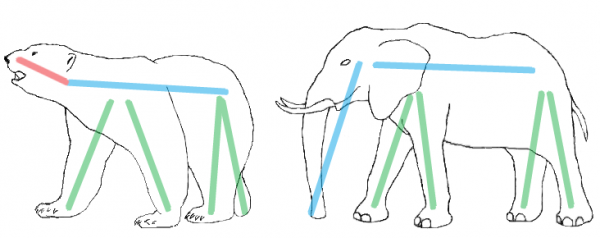这次的CF除了最后一个都比较简单,
第一次用JAVA写CF.......
Two polar bears Menshykov and Uslada from the St.Petersburg zoo and elephant Horace from the Kiev zoo got six sticks to play with and assess the animals' creativity. Menshykov, Uslada and Horace decided to make either an elephant or a bear from those sticks. They can make an animal from sticks in the following way:
Your task is to find out which animal can be made from the given stick set. The zoo keeper wants the sticks back after the game, so they must never be broken, even bears understand it.
The single line contains six space-separated integers li (1?≤?li?≤?9) ― the lengths of the six sticks. It is guaranteed that the input is such that you cannot make both animals from the sticks.
If you can make a bear from the given set, print string "Bear" (without the quotes). If you can make an elephant, print string "Elephant" (w?thout the quotes). If you can make neither a bear nor an elephant, print string "Alien" (without the quotes).
If you're out of creative ideas, see instructions below which show how to make a bear and an elephant in the first two samples. The stick of length 2 is in red, the sticks of length 4 are in green, the sticks of length 5 are in blue.

It's time polar bears Menshykov and Uslada from the zoo of St. Petersburg and elephant Horace from the zoo of Kiev got down to business. In total, there are n tasks for the day and each animal should do each of these tasks. For each task, they have evaluated its difficulty. Also animals decided to do the tasks in order of their difficulty. Unfortunately, some tasks can have the same difficulty, so the order in which one can perform the tasks may vary.
Menshykov, Uslada and Horace ask you to deal with this nuisance and come up with individual plans for each of them. The plan is a sequence describing the order in which an animal should do all the n tasks. Besides, each of them wants to have its own unique plan. Therefore three plans must form three different sequences. You are to find the required plans, or otherwise deliver the sad news to them by stating that it is impossible to come up with three distinct plans for the given tasks.
The first line contains integer n (1?≤?n?≤?2000) ― the number of tasks. The second line contains n integers h1,?h2,?...,?hn (1?≤?hi?≤?2000), where hi is the difficulty of the i-th task. The larger number hi is, the more difficult the i-th task is.
In the first line print "YES" (without the quotes), if it is possible to come up with three distinct plans of doing the tasks. Otherwise print in the first line "NO" (without the quotes). If three desired plans do exist, print in the second line n distinct integers that represent the numbers of the tasks in the order they are done according to the first plan. In the third and fourth line print two remaining plans in the same form.
If there are multiple possible answers, you can print any of them.
In the first sample the difficulty of the tasks sets one limit: tasks 1 and 4 must be done before tasks 2 and 3. That gives the total of four possible sequences of doing tasks : [1, 4, 2, 3], [4, 1, 2, 3], [1, 4, 3, 2], [4, 1, 3, 2]. You can print any three of them in the answer.
In the second sample there are only two sequences of tasks that meet the conditions ― [3, 1, 2, 4, 5] and [3, 1, 4, 2, 5]. Consequently, it is impossible to make three distinct sequences of tasks.
简单题....
Polar bears Menshykov and Uslada from the zoo of St. Petersburg and elephant Horace from the zoo of Kiev decided to build a house of cards. For that they've already found a hefty deck of n playing cards. Let's describe the house they want to make:
Please note that the house may end by the floor with more than one room, and in this case they also must be covered by the ceiling. Also, the number of rooms on the adjoining floors doesn't have to differ by one, the difference may be more.
While bears are practicing to put cards, Horace tries to figure out how many floors their house should consist of. The height of the house is the number of floors in it. It is possible that you can make a lot of different houses of different heights out of n cards. It seems that the elephant cannot solve this problem and he asks you to count the number of the distinct heights of the houses that they can make using exactly n cards.
The single line contains integer n (1?≤?n?≤?1012) ― the number of cards.
Print the number of distinct heights that the houses made of exactly n cards can have.
In the first sample you can build only these two houses (remember, you must use all the cards):

Thus, 13 cards are enough only for two floor houses, so the answer is 1.
The six cards in the second sample are not enough to build any house.
到10^12总共只要80W种可能的层数,鉴于CF的强大机器直接暴力....

上一篇 iframe自适应高度